Designing the Spectator Experience
Paper by: Stuart Reevea, Steve Benford, Claire O’Malley and Mike Fraser
Summary of paper:
In the paper Designing the Spectator Experience by Stuart Reeves, Steve Benford, Claire O’Malley and Mike Fraser, they have discussed about how the spectators should experience a performer’s interaction with a computer? To show the ways in which interaction affects and is affected by spectators. Every action that is performed has its manipulations by the performer and the effects of it hidden, partially revealed, fully revealed or amplified to the spectators. The manipulation by the performers is the input in the interface and the effects that the spectators see is the output of these manipulations. In a broad view of performance the artists, musicians and the actors implicitly perform interactions to be seen in a public environment, whereas in workplace studies, the interactions are performed in a controlled room environments. But we observe how these design settings in theatres, exhibitions, galleries amusement arcades, theme-parks and museums interact with the spectators. The aim of this paper is to help interface designers to familiarise them public interface designs and also the techniques.
Public and Private interactions:
Personal phone calls is often a private action, where the outsiders cannot view the action conducted though in a public environment. A performance by artist using interactive technology but are careful in what they reveal in a public setting. There are some in-between interactions such as in museums, where one user is directly involved in the interaction while the other bystanders learn and watch. A more expressive way to show distinct possibilities, the interaction is sub-divided into manipulations and effects.
Manipulation:
Actions carried out by the performer which may include physical controls like buttons, mouse or a joystick and also gestures, movements and speech which may not directly be the input. Using gestures sometimes play two important roles, one: interactions are more than just the contact with the interface and secondly, performing interactions helps spectators to appreciate, express skills or control and use aesthetic components of the technology.
Effects:
It is the result of these manipulations which can be display of images, audio or video. These effects include the apparent action of the interface on the performers as well. When performers display physical or emotional reaction to the interface, the output as gestures, movements or expressions around the interface can be seen as part of the effect.
Hidden:Manipulations and effects are hidden for the spectators but are only accessible by the performer. e.g: Kiosk photo booth
Revealed:Both effects and manipulations are revealed to the spectators. e.g: Single Display Groupware – people collaborate around a shared display
Partially revealed/hidden:The effects are revealed but the manipulations are hidden sometimes even from performers (magic like effects). e.g: Wizard of Oz
Amplified:Here the manipulations are revealed by the performer but the effects are hidden. e.g: immersive head displays used in public settings allowing the spectators to only see the performer’s manipulations.
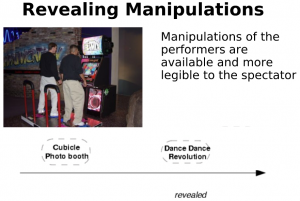
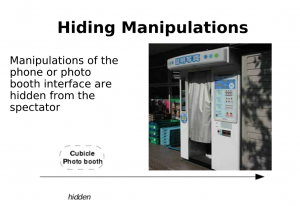
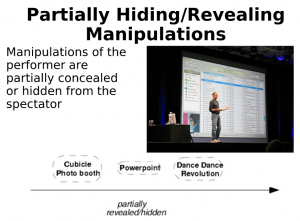
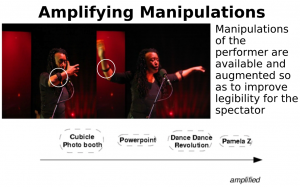
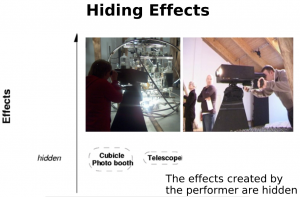
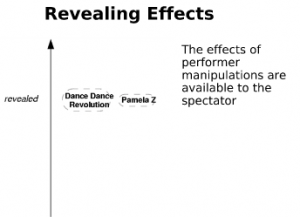
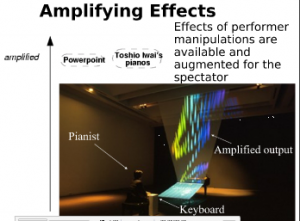
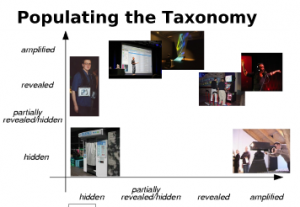
Picture from: Designing the Spectator Experience Stuart Reeves1, Steve Benford1, Claire O’Malley1 and Mike Fraser2 – PowerPoint PPT
http://www.powershow.com/view1/bc305-ZDc1Z/Designing_the_Spectator_Experience_Stuart_Reeves1_Steve_Benford1_Claire_OMalley1_and_Mike_Fraser2_powerpoint_ppt_presentation
Performances:
When artists perform with interactive technology are not always content in revealing their manipulations, but amplify the manipulations to make their performance more expressive. Sometimes amplification is not involved in all performances.
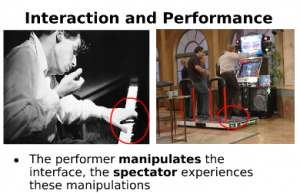
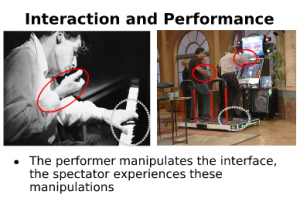
Taxonomy:
There are four genera approaches to design public interfaces.
Secretive: Interface tends to hide both the manipulations and the effects
Expressive: Interface tends to reveal sometimes amplify both the manipulations and the effects.
Magical: Interface tends to reveal effects but hide the manipulation that led to them.
Suspenseful: Interface tends to reveal manipulations while hiding the effects.
We can also see that there are more possibilities for our interfaces that simply reveal or hide manipulations /effects.
Partially revealing: the interface partially reveals the manipulations and the effects depending on the scale of the interface or the distance of the performer form the spectators.
Transforming: A possible way to transform our manipulations, either through non-linear mapping or aggregating multiple inputs when mapping it to the effects.
Amplifying: The performers may amplify their manipulations and effects rather than revealing them.
Other facets:
There are many other aspects for designing the performer interface, which some are discussed in the paper which is relevant to works related in this research.
Interactive spectators:
Possibility of the spectators to interact with the interface. While performing, a performer is aware of spectators and how their reactions shows the flow in the performance. For example, the authors have talked about the techniques for aggregating the spectator input form audience voting system to video-tracking crowd behaviour which are expressed for the interactive experiences and how the presence of the spectators brings a sense of liveness to the performance.
Performer awareness of spectator:
The awareness of spectators may also have a negative impact on the performer making him pressurised, to perform better or potential embarrassment of making mistakes. An example that was discussed here was Uncle Roy All Around You, a game-like performance where public used wireless PDAs to search the city for mysterious characters. This was a see a performer’s experience in a public environment which enhanced the awareness of the spectators.
Transitions and Handovers:
There are many transitions between the spectators and the performers, especially in exhibitions or museums where the visitors change the controls of the exhibits to each other. An example to emphasize on the transitions, where a painted scene with two figures and their faces were painted on the doors. There were small screens behind the door linked to mirrors. When a person performed the act by looking into the mirror, their face was captured on a hidden video camera and then it was displayed on one of the screens in the painting. As a result the performers could not see the effect of their own manipulations but it was the spectators that pointed to the performer that his/her face can be seen on the screen.
Orchestration:
Most stage performances usually have a set of activities that are used to having a smooth running of the experience. These set of activities can be the people such as the ushers, receptionists or announcers that deal with the front end of the theatre and the back end of it is done by for example, the stage managers, floor managers, prompters or the technical crew. The orchestrators will have to be aware of the manipulations and the effects of other participants, spectators and even the performers.
Conclusion:
A significant raise in designing the interfaces is a new challenge for HCI, one being the spectator interface. To validate the approaches the authors have developed a taxonomy that expresses the differences and brings out the underlying approach to design. The taxonomy is to complement other frameworks for designing public performances. The performer’s use of interface is the actions or the manipulation which then lead to the effects. The event that are viewed by the spectators that is the effects from the manipulation of the performers can be hidden, partially hidden, transformed, revealed or amplified.
Some of the other design issues were, can the spectators also interact; the performers awareness of the spectators, supporting fluid transitions between spectating and performing; and support for behind-the-scenes operation. Designing the spectator experience will be an increasing and challenging part of HCI which requires deeper understanding of new issues such as expression, suspense and magic. This taxonomy that was published is just a start for the challenges involved and also to the range of potential solutions available.









